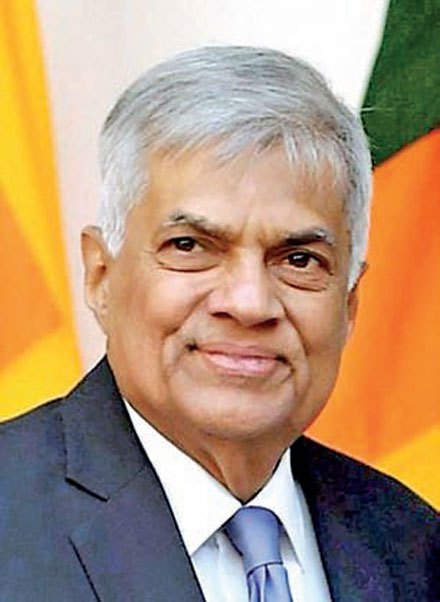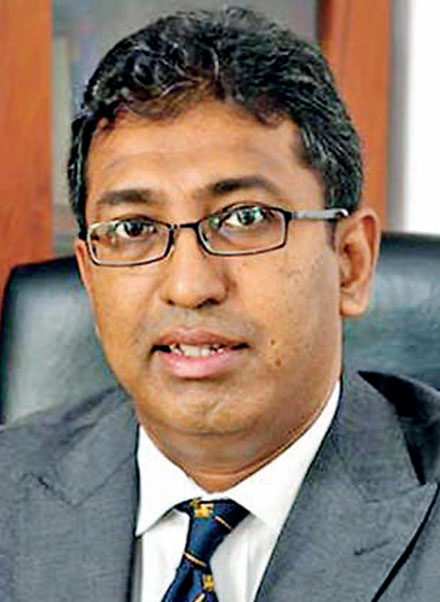Friday Dec 26, 2025
Friday Dec 26, 2025
Thursday, 29 September 2022 02:15 - - {{hitsCtrl.values.hits}}

President Ranil Wickremesinghe

SJB MP Dr. Harsha de Silva
|
 President Ranil Wickremesinghe’s High Security Zones have an unintended upside. One can easily map the contours of the power-base of the Rajapaksa-undergirded Ranil regime, or the Ranil-Rajapaksa regime. The offices and official residences, the military establishments, the Parliament (with an SLPP majority), the residences of parliamentarians and – as an exception – the courts.
President Ranil Wickremesinghe’s High Security Zones have an unintended upside. One can easily map the contours of the power-base of the Rajapaksa-undergirded Ranil regime, or the Ranil-Rajapaksa regime. The offices and official residences, the military establishments, the Parliament (with an SLPP majority), the residences of parliamentarians and – as an exception – the courts.
The courts are included because the regime worries that the arrival of Wasantha Mudalige or similar others will mean a huge number of people holding pickets outside in support and solidarity. So, if you deduct the courts, the High Security Zones that remain are the only safe zones the regime can count on. The new cartography marks the enclave of Wickremesinghe rule. It is the Forbidden City within Colombo city.
Hyper-securitised space
The HSZs create a system of horizontal apartheid. The hyper-securitisation of space through the new cartography by Ranil Wickremesinghe, follows the hyper-centralisation of political power through the 20th Amendment by Gotabaya Rajapaksa. Combine the two, the 20th Amendment and the HSZs in a holographic projection and you will see the horizontal and vertical axes of power in Sri Lanka. You will see the autocratic, near-tyrannical, matrix of power.
The High Security Zones are not a show of strength; they are a revelation of political, or more correctly socio-political, absence and weakness. They show the politico-legitimacy vacuum, the vacuum of popularity and public consent, that the Ranil Presidency is operating in.
The irony of it all is that Ranil Wickremesinghe’s Ceasefire Agreement (CFA) with Velupillai Prabhakaran permitted the Tigers to re-enter areas that had been liberated from them by the armed forces, sacrificing life and limb, while the Sri Lankan State and its armed forces were not allowed to reciprocally enter the zones under LTTE control.
Wickremesinghe was much kinder to Prabhakaran (who moved to No. 2 spot as the world’s worst terrorist only after Osama Bin Laden hit the Twin Towers on 9/11) than he has been to Wasantha Mudalige, the unarmed student leader who languishes in detention under the Prevention of Terrorism Act drafted for Prabhakaran and his Tigers (it was originally the ‘Tiger Law’, i.e., the Proscription of Liberation Tigers and Other Similar Organisations Special Provisions Act).
Worse still, a respected Sunday newspaper scooped the report presented to (then) Prime Minister Ranil Wickremesinghe by the US Pacific Command PACOM study team which sounded the alarm about the LTTE artillery build-up during the CFA, in the zone dominating the Trincomalee harbour. Wickremesinghe, it is alleged, kept the report safely locked away.
When it was leaked, President Chandrika Kumaratunga and her Foreign Affairs Advisor Lakshman Kadirgamar flew to Delhi to alert the Indian Prime Minister Dr. Manmohan Singh, about the threat to both countries. India’s dove-ish High Commissioner Gopalkrishna Gandhi was swiftly replaced by the steely stellar Nirupam Sen.
Sandhurst Senior instructor Prof. Paul Moorcraft wrote in his book on the defeat of the Tigers, that Prime Minister Wickremesinghe overrode Army commander Lionel Balagalle’s entreaties and cancelled the LRRP hit on Prabhakaran due on 21 Dec. 2001, pulling out the Special Forces team. That hit could have saved tens of thousands if not hundreds of thousands of lives that were lost in the mid-intensity quasi-conventional war that finally ended the conflict.
The same Ranil Wickremesinghe who allowed the Tigers into the Sri Lankan State’s liberated zone while respecting the Tigers’ zones of control as no-go areas, has stopped peaceful demonstrations by unarmed Sri Lankan youth in his High Security Zones in Colombo.
The High Security Zone is a euphemism for a future free-fire zone with ‘weapons free’ rules of engagement. Outside the High Security Zones lies what the President seems to think is bandit country, the Badlands, i.e., where the overwhelming majority of the citizenry lives.
Soon the people may turn the rest of the island, area by area, into ‘liberated zones’, comprising the ‘free territory’– or the Ranil-free territory – of the island of Sri Lanka.
|
Ranil’s time-travels
President Wickremesinghe declared the High Security Zones invoking the Official Secrets Act of 1955. Note the year. Ceylon did not have an Official Secrets Act from 1948. It rightly regarded the Public Security Ordinance, denounced as draconian by Dr. Colvin R. de Silva at the time of its promulgation in 1947 while describing it as the rope with which the proletariat would hang the bourgeoisie (he later embedded it in his 1972 Constitution) as more than sufficient to cover all security-related contingencies.
The Official Secrets Act which President Wickremesinghe invoked was not passed by the UNP Government of Prime Minister Dudley Senanayake elected in 1952. It was passed in 1955 by the UNP administration of Sir John Kotelawala who was picked as successor Senanayake after the latter resigned in the face of the Hartal of August 1953 (ancestor of the Aragalaya of 2022).
Sir John’s top advisor was the present President’s father, Esmond Wickremesinghe, a Trotskyist turned Dulles-ist (not just John Foster but also Allan, according to early whistle-blowers).
Therein lies a political morality tale. The hawkish Kotelawela UNP administration which promulgated the Official Secrets Act in 1955 found that playing tough-guy can blow back. The social backlash, downstream from the Hartal of 1953, took Sir John out of politics to hunting foxes in self-exile in Kent, while the UNP was exiled from governmental office for a decade. Ranil Wickremesinghe, as much of an unelected leader as Sir John was – both hawkish successors chosen in the backrooms of ruling parties after a popular uprising – should learn the lesson. President Wickremesinghe said in Parliament that Queen Elizabeth II was the last monarch of Sri Lanka, the first monarch being King Vijaya. What all of us learned in school was that our first monarch was King Vijaya while our last was King Sri Wickrema Rajasingha – and we were taken to see the pathetically tiny cell he was held in by the British (abutting the wall of what became the Ceylinco building).
The British monarchy was imposed on us by colonial conquest and feudal treachery, and was never included in the island’s narrative of its rulers. The British sovereign became our sovereign when we lost our sovereignty. Anyway, if he imitates Sir John’s testy arrogance and the electorate reacts in the way it did to that UNP martinet, President Wickremesinghe will surely enjoy his self-exile in Kent (with or without the fox-hunts).
Re-radicalising the JVP
Ranil’s invocation of the Official Secrets Act reminds me of an anti-Brezhnev joke that used to be cracked by Russian journalists (well, they were also journalists) knocking back vodka with my father. A man is jailed for 25 years for calling the Soviet leader Leonid Brezhnev an idiot. He protests his sentence saying he was drunk and only joking. The judge sternly admonishes him for implying that under Soviet socialism he would be jailed to 25 years for a drunken joke. He informs the man that of the 25 years, only five are for insulting the President and 20 for publicly disclosing an official secret.
Take the events of the last few days. Last week, the JVP’s Dr. Nalinda Jayatissa, a member of the party’s leadership and one of its most effective public communicators, appeared on Faraz Shauketaly’s TV show and publicly articulated a significant shift in economic policy. Not only was the party for export-led growth, it would welcome private enterprise, local and foreign, in many sectors including higher education provided the Government could guarantee a level-playing field through a regulatory framework.
This was a significant shift of the island’s major Left-party to a policy which was still progressive and left-oriented but not describable as socialist or anti-capitalist. Hardly 48 hours after Dr. Nalinda Jayatissa’s significant policy declarations, the JVP’s Socialist Youth Union (SYU) was mauled by the Police outside the new High Security Zone and 84 youths were arrested.
That evening, an angry Anura Kumara Dissanayake arrived at the Maradana Police station. By the next day he announced at the impressively attended Akuressa conclave that the Aragalaya had been a tad underwhelming (“tikak madi vagey neyda?”), and that was because of leadership flaws; the next round of the Aragalaya would be led by the JVP-JJB and would have a clear-cut goal; the securing of an early national election.
Ranil’s crackdown on the JVP’s student wing has brought the SYU on to the same page as the FSP-influenced IUSF. The SYU demonstration and its violent suppression has generated the sense among the SYU that it is the new vanguard of the new Aragalaya, in no way smaller, weaker, less militant or numerous than Wasantha Mudalige’s IUSF. The SYU and IUSF will either draw closer together or compete with one another on exactly the same terrain.
Ranil’s repression of the youth demonstration has swung the “adults in the room” JVP-JJB leadership solidly behind their more militant youth wing. Any party leadership would have to do likewise. More importantly, almost the entire JVP leadership comes from the university student movement and is outraged that their ‘kid brothers and sisters’ were gratuitously beaten-up.
Perhaps Ranil hopes to push the JVP and FSP together for better targeting. He seeks to evict the JVP-JJB from the electoral arena as a threat to the SLPP-UNP axis. He may think that removing the JVP-JJB from the electoral board would also relieve the competitive pressure on the centrist SJB, whose neo-Ranilist right-wing would be able to more easily drag the party into an alliance with the UNP if the SJB didn’t have to look over its shoulder at the JVP competition. Such a reckless calculus will polarise society, overload the circuits and collapse the system.
President Wickremesinghe is to his uncle J.R. Jayewardene what Louis Bonaparte was to his uncle Napoleon Bonaparte; a farcical caricature. Before he assumed the Executive Presidency in 1978, J.R. Jayewardene led the UNP to a 5/6ths majority in Parliament in 1977. Before he popped into the Presidency in 2022, Ranil Wickremesinghe lost his Colombo electorate and led the UNP to electoral extinction in in 2020.
|
Sado-economics and Harsha’s hash-up
An electoral moment custom-tailored for a progressive-centrist, social democratic option such as Sajith Premadasa’s SJB, may tip over for better or worse to the committed hardcore Left for the first time since Independence. In a newspaper interview this week, Dr. Harsha de Silva, the SJB’s main economic ideologue (it beats me why Sajith shouldn’t be its ‘Development policy’ guru) unwittingly reveals why.
1. He regards the Ranil Presidency as “legitimate”. His sole critique is that Ranil’s enlightened economics “prone to be very painful for the people” (I’d call that ‘sado- economics’) cannot be implemented in the unenlightened company that Ranil keeps: “Given that RW is constitutionally the legitimate President it is difficult to state whether he can convince the people who are around him and those who are keeping him afloat to undertake the kind of reforms that are prone to be very painful for the people… Sadly, these people who are with him have completely opposed these reforms. They have been advocating for large public sector spending and all kinds of freebies. They have not supported the integration of Sri Lanka with the world. So, the ideology of the RW Government is poles apart from Ranil Wickremesinghe himself…”
2. Though logically, one’s role-models in politics and economics should be success stories, not failures, Harsha ignores the politico-electoral failure of Ranilonomics when Ranil had supportive UNP Cabinets on two occasions (2001-3, 2015-19). With utterly misplaced arrogance, Harsha conspicuously fails to mention even once in the substantive interview, the proven, outstanding success in the twin realms of rapid economic recovery and upliftment of the poor, namely that of President Ranasinghe Premadasa, the developmental genius and giant whose track-record of achievement makes his paradigm the obvious policy template for the SJB led by Sajith Premadasa.
3. Harsha patronisingly asserts that: “Sajith has evolved over time. His thinking from subsidies to reforms has evolved. He has a team comprising me, Eran and Kabir… We are for a market liberalism… Not handouts and freebies.”
Politically and electorally, this is both nonsensical and suicidal. Before he “evolved” (thanks to the evangelism of market liberals), Sajith with “subsidies” polled an impressive 42% in November 2019, just 10% below Gotabaya and 8% below the magic 50%. Ranil’s economically correct UNP got 23% in February 2018, and the successor SJB got the UNP’s 23% in August 2020. The spike was the ‘unevolved’ Sajith with ‘subsidies’.
Harsha’s economic line to which Sajith has allegedly converted, deletes Sajith’s inherited, inbuilt ‘comparative advantage’ over the JVP at a time of spiralling povertisation, namely his ability to credibly invoke the policies and record of delivery of President Ranasinghe Premadasa. Thanks to Sajith, the SJB potentially has that franchise.
For at least a quarter-century, the world over, leaderships and governments administering neoliberal shock therapy have been toppled by anti-incumbency populist waves of leftist or nationalist varieties and replaced mainly by centre-left or left-leaning administrations.
An Opposition party can win an election promising a neoliberal economic package but only if the incumbent it is opposing has been a closed-economy ‘statist’ (e.g., Sri Lanka, 1977), not a neoliberal himself/ herself. No Opposition party wins by promising more of the same as the incumbent adversary.
There is no significant electoral victory of recent years that has been obtained on a platform of ‘market liberalism’. Commenting on this year’s Davos summit, Joe Stiglitz said the consensus was that neoliberal globalisation had failed. From the USA through France to New Zealand, from Mexico through Colombia to Chile, the winning economic policies have mostly been skewed towards the Rooseveltian-Keynesian-Galbraithian-Stiglitsian paradigm, with the Latin American outcomes reinforced by left-populism.
All perfectly compatible with President Premadasa’s “new political, social and economic democracy” (A Charter for Democracy 1989). Ranasinghe Premadasa was not about ‘market liberalism and political liberalism’.
Harsha says: “Our party will be the major player at the polls to bring like-minded people together.” The choice before Sajith and the SJB is clear: either (a) an alignment for Harsha’s “market liberalism and political liberalism”, incorporating the UNP under Ranil Wickremesinghe, always the easiest target in an election, or (b) an alliance for President Premadasa’s “new political, social and economic democracy?” In short, the Right/Centre-Right or the progressive centre/social-democratic Centre-Left?
If Harsha and Eran (Kabir had spoken sensibly at a Peradeniya University forum last week) insist on keeping the SJB on a continuum with Ranil’s economics rather than support Sajith to present a paradigmatically Premadasa-ist alternative, the SJB will be perceived by voters as a substitute for Ranil, not a clear-cut alternative to him.
Nowhere does a majority vote for a market-liberal clone or substitute instead of an alternative to neoliberal shock therapy. On the street, in the protests reviving and revving-up for the next cycle, Ranil is ‘The Enemy’. Any endorsement of him in any dimension, any soft-peddling of the anti-Ranil struggle in the central economic arena by the SJB on the basis of shared economic ideology, and the anti-incumbency wave will be splendidly surfed by the intransigently anti-Ranil, anti-neoliberal Left.